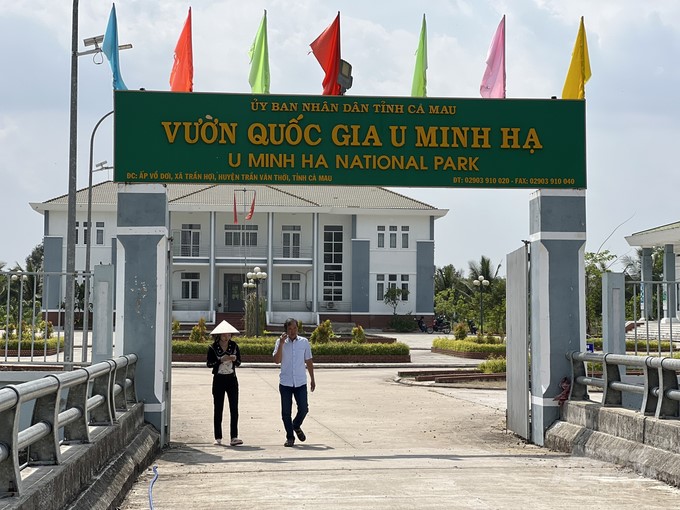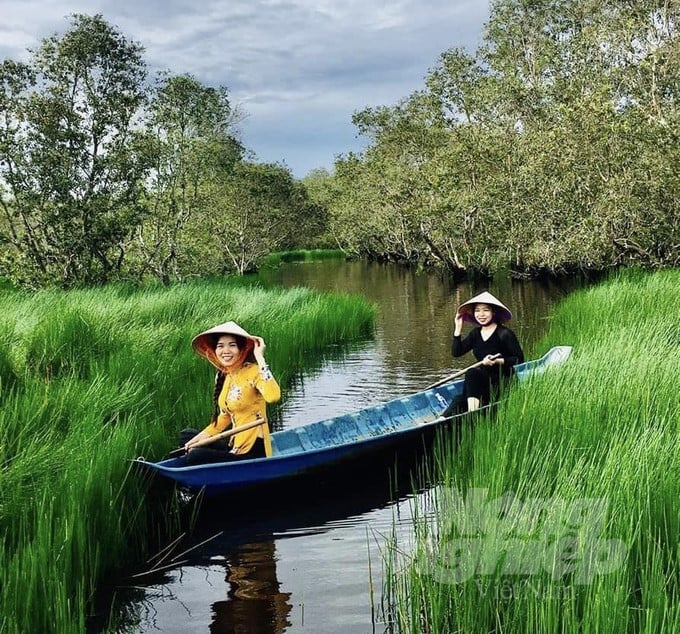June 18, 2025 | 21:41 GMT +7
June 18, 2025 | 21:41 GMT +7
Hotline: 0913.378.918
June 18, 2025 | 21:41 GMT +7
Hotline: 0913.378.918

U Minh Ha National Park. Photo: Trong Linh.
According to Mr. Nguyen Tan Truyen, Head of Ecotourism and Environmental Education Department, U Minh Ha National Park is one of 34 national parks nationwide and has been recognized by UNESCO as one of the three core areas of the Mui Ca Mau Biosphere Reserve.
U Minh Ha National Park currently manages more than 1,760 ha of primitive forest. This is Ca Mau’s unique remaining primary forest area with approximately 176 species of natural plants, 23 species of mammals, 91 species of birds, and 47 species of reptiles, amphibians, and many other insects.
The national park's forests also have more than 136 km of canals with a total water surface area of over 1,000,000 m2 (not including the area of seasonally waterlogged lawns). This is truly a paradise for freshwater fish to thrive.
With its potential and strengths, U Minh Ha National Park is one of the most attractive ecotourism destinations for tourists. Especially in the fishing season, tourists can easily encounter some fish species with scientific and economic value, such as the snakehead, snakeskin gourami, three-spot gourami, yellow catfish, climbing perch, bronze featherback, etc.
The fauna here is not only abundant in species composition but also has a very high individual concentration level. Tourists can see firsthand the troops of monkeys climbing trees to pick fruit or bird species flying back and forth in bustling flocks, which is a marvel to behold.
On the other hand, U Minh Ha National Park is also the homeland of many traditional craft villages with specialties originating from the indigo forest ecosystem. Combining these rich cultural values will contribute to U Minh Ha's development of ecotourism.

Mr. Tran Cong Hoang, Director of U Minh Ha National Park said the ecotourism trend is risen in the past few years, especially after the COVID pandemic outbreak. Photo: Trong Linh.
"Because the ecotourism trend of domestic and foreign tourists tends to increase in recent years, especially after two years of the COVID pandemic outbreak, the number of tourists every year rises remarkably. Therefore, the Party Committee and People's Committee of Ca Mau province is paying keen interest to developing ecotourism, including U Minh Ha National Park," said Mr. Tran Cong Hoang, Director of U Minh Ha National Park.
"The unit has also built an ecotourism development scheme and called for future investment in the field of tourism. Up until now, the scheme has been basically completed and was submitted to Ca Mau Department of Agriculture and Rural Development and Ca Mau People's Committee for approval to call for investment in items. But the forest development and protection works are still one of the most important tasks," said Director Tran Cong Hoang.
In recent years tourism activities in U Minh Ha have to face many difficulties. Tourism activities remain monotonous and small-scale. The infrastructure system remains limited. The quality of ecotourism services is not guaranteed. Management staff and ecotourism guides have yet to meet the tourists’ demand. Tourism products and market objects remain unclear. As a result, the ability to attract tourists remains still projects certain limitations. Due to the difficulties and limitations of reality, tourism activities in U Minh Ha National Park have not developed in proportion to their potential and advantages.

After the COVID-19 pandemic, the ecotourism model tends to attract many tourists. Photo: Trong Linh.
It can be said that tourism in U Minh Ha National Park is very diverse at the moment, with a wide variety of tourism models: visits to research fauna, flora, and indigo forest ecosystems at U Minh Ha National Park; visits to the specimen gallery center, visits to the fauna, flora, and medicinal herb collection garden This types of tourism models are suitable for students, domestic researchers, and even foreign researchers.
Cultural tourism includes visits to craft villages such as those for apiculture, drying crafts, and banana dry-pressing crafts; visits to the models that recreate the stories of Uncle Ba Phi. Tourists can enjoy honey and dried fish, or buy products from craft villages.
Regarding entertainment tourism, tourists can enjoy picnics, recreational fishing services, or traditional games such as scooping water with buckets, fishing contests, traditional food camps, and organizing marathons through the forest (jogging, walking, cycling, etc.).
As for ecotourism models, tourists can enjoy the overall view of more than 8,500 ha of indigo forest area, travel by canoe along the canals, lie in hammocks and feel the cool breeze, immerse themselves in "Don ca tai tu" folk songs, plant souvenir trees, have family meals in outdoor restaurants, buy handmade souvenirs and specialties, and experience other resort services.
If interested in exploring tourism, tourists can trek into the indigo forest maze to contemplate the old forest and explore the fauna, flora, and natural beehives, visit animals in the collection garden, or go see the animals under the night sky.
Culinary tourism is one of the highlights that attract most tourists to Ca Mau in particular. Having a rich variety of famous folk dishes nationwide, folk cuisine can be considered a signature of this province.

Many tourists are students coming to U Minh Ha National Park to experience and explore. Photo: Trong Linh.
"The sustainable development of U Minh Ha National Park tourism is closely associated with conservation and development of U Minh Ha’s significantly diverse forest ecosystem. At the same time, it can help preserve the landscape, protect the environment, and ensure the harmonious interaction between tourism development and exploitation with the protection of the value of natural resources,” Mr. Nguyen Tan Truyen, Head of Ecotourism and Environmental Education Department, U Minh Ha National Park said.
As a result, it is possible to assess the current state of natural and cultural tourism resources, scenic entertainment, history, and spirituality values in U Minh Ha National Park to come up with solutions to attract investment and promote tourism development activities.
Translated by Huyen Vu
![Turning wind and rain into action: [9] Digitizing hydrometeorological data in response to climate change](https://t.ex-cdn.com/nongnghiepmoitruong.vn/608w/files/news/2025/06/17/z6704423696987_15fd32ffc26d590d204d520c9dac6786-nongnghiep-165943.jpg)
(VAN) Farmers have begun accessing hydrometeorological applications to adjust their cropping schedules, aiming to ensure productivity and adapt to climate change.
![Turning wind and rain into action: [8] Real-time salinity detection and early warning technology](https://t.ex-cdn.com/nongnghiepmoitruong.vn/608w/files/news/2025/06/17/z6704423696987_15fd32ffc26d590d204d520c9dac6786-nongnghiep-151127.jpg)
(VAN) Thanks to the integration of modern hydrological-hydraulic models, remote sensing technologies, and artificial intelligence, the accuracy of hydrological forecasting has significantly improved.
![Turning wind and rain into action: [7] Early disaster warnings help marine farmers minimize losses](https://t.ex-cdn.com/nongnghiepmoitruong.vn/608w/files/news/2025/06/17/z6704423696987_15fd32ffc26d590d204d520c9dac6786-nongnghiep-142942.jpg)
(VAN) In recent years, thanks to early disaster warnings and forecasting, marine farmers in Khanh Hoa province have been able to reduce risks and losses, thereby improving production efficiency.
![Turning wind and rain into action: [6] ‘Four on-the-spot’ disaster management software](https://t.ex-cdn.com/nongnghiepmoitruong.vn/608w/files/news/2025/06/17/e5a48259d6a262fc3bb3-nongnghiep-183800.jpg)
(VAN) By simply activating the scenario on the disaster management software, the relevant authorities immediately know how many households need to be evacuated, where to evacuate them to, and by what means of transportation…
![Turning wind and rain into action: [5] Hue applies modern technology in disaster forecasting](https://t.ex-cdn.com/nongnghiepmoitruong.vn/608w/files/news/2025/06/17/z6704423696987_15fd32ffc26d590d204d520c9dac6786-nongnghiep-093938.jpg)
(VAN) In Hue city, modern technology has recently been applied in meteorological and hydrological forecasting and warning, helping to reduce the damage caused by natural disasters.

(VAN) A cutting-edge farming technique being implemented on an experimental ranch in Arizona's Sonoran Desert has already saved a billion gallons of water over five years, according to Civil Eats.

(VAN) Poultry and pig production and the environment can be boosted through enhanced water technology, according to new research.